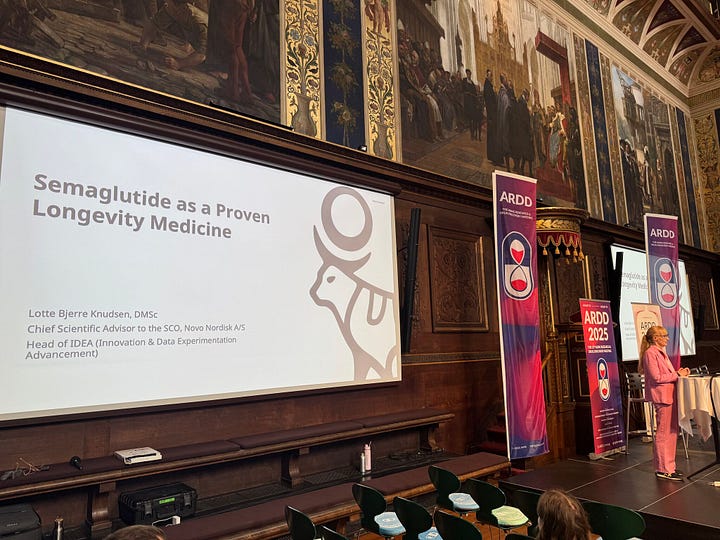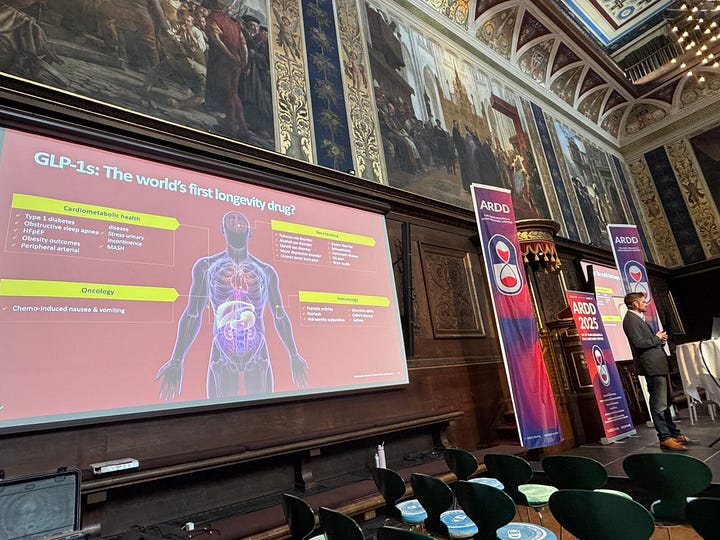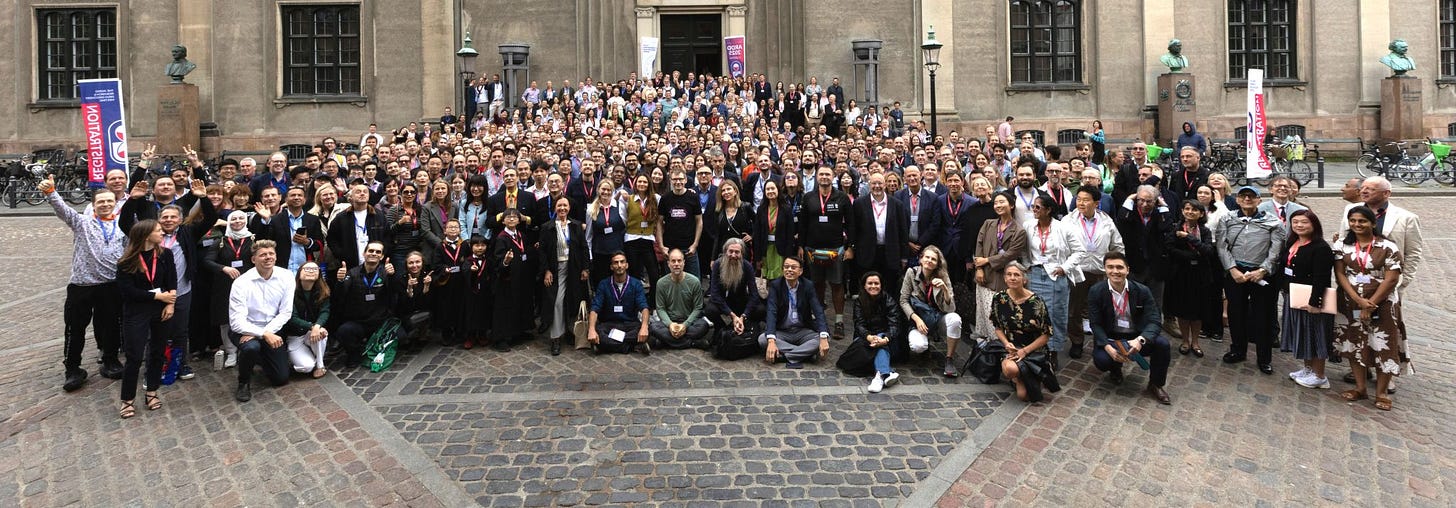Field notes: ARDD 2025
An exciting aging conference (w 995 schedule + drinks... thanks CH+DK organizers). Pharma paying attention to longevity like never before. New mega-institute. Clinical trials reading out end of year.
Aging Research & Drug Discovery is arguably the top longevity conference, unusual in bringing together both academics, physicians, companies, and other parts of the community. This year had a lot of cool updates, with highlights below:
Science Highlights (skipping most of the published work)
They had parallel tracks this year, so I didn’t catch every presentation.
Max Yun shared details on aging in axolotls in her colony. They live ~10 years and regenerate throughout life. Many features of human aging are absent: 1) no senescent cells, at least by common markers, 2) no telomere shortening, 3) no loss of stem cells, 4) their thymus doesn’t disappear like in humans, 5) ~flat risk of death by age. So how do they die? She doesn’t know yet. One observation is that their adaptive immunity is very weak, leaving them prone to infections (this is also true of naked mole rats).
Apropos, Emma Teeling shared findings from large-scale epidemiology and sequencing of different bat species finds that short-lived bats have increased innate immune activity with age, while long-lived bats decrease activity.
Björn Schumacher and Zane Koch showed early data linking the DREAM protein complex, DNA damage and repair, and neurodegeneration. This is cool both because DREAM is probably druggable, which DNA repair generally isn’t. And because while DNA mutations correlate inversely with lifespan, we don’t know what mechanisms are involved. (Björn’s paper)
Juan Carlos Belmonte of Altos and James Kirkland of Cedars-Sinai were both using transplant organs as a system for testing putative aging therapies - this is cool since it’s a real aged system, ‘transplant success’ is a fast readout, and success could have a commercial outlet before direct human application.
More clocks, although still nothing with blinded prospective validation… Andreas Berger is looking to make single-cell transcriptomic signatures of cellular injury to compare with aging, by comparing overlaps between different injuries. Alexander Tyshkovskiy from Gladyshev lab made a cross-species, cross-cell-type transcriptomic clock that captures both in vivo and culture “aging” - to me, this suggests it’s focused on cell intrinsic changes, maybe epigenetic, since that’s what would be shared with cultured cells. Tony Wyss-Coray shared a (published) Alzheimer’s predictors based on YWHAG/NPTX2 protein ratio in CSF or blood.
There was a refreshing number of presentations from labs new/adjacent to the aging field: Sophia Liu shared spatial transcriptomics exploration of thymic function and changes with age, Uri Alon is working on modeling species lifespan, and argued that heritability of lifespan is actually ~50% when you normalize for extrinsic mortality in twin studies. Very satisfying to see many of these funded by Impetus Grants a couple of years ago, now bearing fruit. Vadim Gladyshev/Bohan Zhang spoke about experiments to study accelerated/reversed aging when organs were transplanted between donors of different ages.
Nice panels on virtual cells & pharma perspectives.
New developments
Todd White announced the non-profit Thalion Institute, intending to spend several hundred million on research and tools with an emphasis on comparative biology. One major component will be a biobank of samples from species with long lifespan or exceptional disease resistance, through life. Assuming this all happens, it should be a great source of new therapeutic hypotheses.
Attendance by pharma companies was higher than ever. Eli Lilly had the greatest presence, consistent with their investment in a new longevity-focused group. During a talk they described GLP1s as “the first longevity drugs” based on their broad effects, as did Lotte Bjerre Knudsen of Novo Nordisk. Novartis and Genentech agreed with this description on a panel. AstraZeneca and Lundbeck were also present. Not all of these are investing in longevity, but all were paying attention and looking for opportunities.


There was a lot of discussion of longevity medicine, and three clinical trials stand out for potential to shift status quo: 1) Eli Lilly’s Alzheimer’s Primary Prevention rial was mentioned (no data yet), which is a rare example of treating for prevention. These trials are expensive but have potential to unlock new surrogate endpoints to speed up later trials. 2) FAST, not strictly a trial but rather using samples from past trials of putative longevity drugs to identify biomarkers of aging. Impetus gave a small amount of early funding, which has now been expanded by Astera and others. No data yet, but excited to see results. 3) Another Impetus-funded trial is VIBRANT-I, testing rapamycin to delay ovarian decline. Youin Suh says they’ll be able to unblind and analyze data by the end of the year. VIBRANT-I one is particularly exciting because the design could be a platform to test other candidate longevity therapies much faster than multimorbidity/morality trials (plus delaying menopause is by itself a huge need). A larger VIBRANT-II study is already bring planned. If this works out it could majorly speed up and validate the field.
Congratulations to organizers Morten Scheibye-Knudsen and Alex Zhavoronkov for a great event. Looking forward to next year.




Great write up